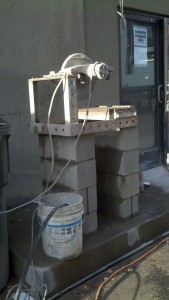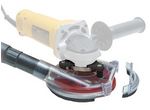Controlling most of these types of exposures is really simple. If you know the job- and you know it will generate airborne silica = Pre Task Plan!
I wish Superintendents would enforce their project managers, or project engineers, to make a pre-task plan for every concrete/silica producing task. Then, (please don’t stop yet), review the plan once the project starts!
Below are two examples with different outcomes:
1. Cutting concrete block.
The pretask plan called for a garden hose with attachment(s) to wet the cutting area. Everything was perfect until the water was shut off. But, they improvised and found an electric water pump with bucket and recycled the water. It was a great outcome. What if the power went out? They could have used a Hudson sprayer.
2. Grinding plaster off a brick wall.
They built an enclosure and containment. They had a negative air machine with HEPA filters. They had a vacuum with HEPA filters, tyvek, 1/2 face respirator, eye protection, etc. But, as they worked the vacuum couldn’t keep up with the amount of dust generated by the 7 inch Bosch grinder. It was really dusty. They worked like this for days. No one onsite saw them because they were in containment. Unfortunately the project is almost over and it could have been better. A simple shroud to the grinder, like this one (no endorcement) might have controlled the dust & silica. Sure, it might have been troublesome to find the exact one, and get a vacuum attachment, and have the extra weight, and ….
So, let’s talk to people about silica, talk about solutions, and then check to see if they’re effective.
